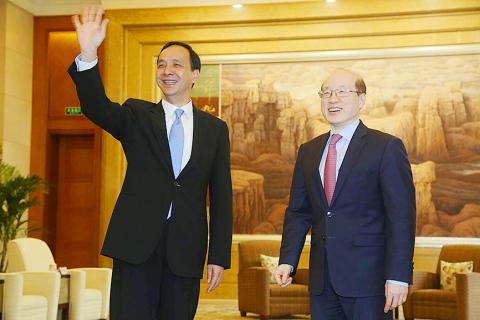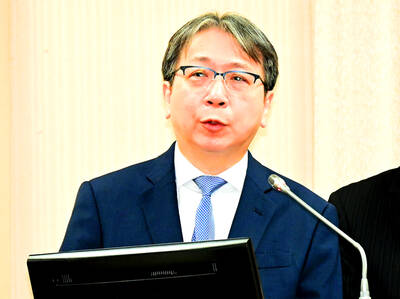New Taipei City Mayor Eric Chu (朱立倫) and China’s Taiwan Affairs Office Minister Liu Jieyi (劉結一) yesterday reiterated the so-called “1992 consensus” as a basis for cross-strait relations as they met in Shanghai.
Chu is the first Taiwanese politician to meet Liu since the Chinese Communist Party’s (CCP) Central Committee announced the former UN ambassador’s appointment earlier this month.
Insistence on the “1992 consensus” has been the consistent position of the Chinese Nationalist Party (KMT), Chu said.

Photo courtesy of New Taipei City Government
Even though the KMT is now the opposition party, this stance would not change, and it hopes that the two sides of the Taiwan Strait can engage in peaceful exchanges and achieve win-win cooperation, Chu said.
Although the political circumstances have changed, what people hope for most is peace, he said.
Local-level exchanges must also continue, as the two sides could learn about city governance from each other, he said.
Beijing insists on the “1992 consensus,” which reflects the “one China” principle and opposes Taiwanese independence schemes in any form, Liu said.
“The mainland’s policies toward Taiwan are to continue to uphold the ‘two sides of the Strait, one family’ ideology,” he said.
China hopes the two sides can work together for the peaceful development of relations and “jointly promote the process of the peaceful reunification of the motherland,” Chinese state media quoted Liu telling Chu.
The “1992 consensus” — a term former Mainland Affairs Council chairman Su Chi (蘇起) said in 2006 that he had made up in 2000 — refers to a tacit understanding between the KMT and the CCP that the two sides acknowledge there is “one China,” with each side having its own interpretation of what “China” means.
In Taipei, the Mainland Affairs Council said the government holds a positive attitude toward city-level cross-strait exchanges, but they must be handled according to relevant guidelines.
Attention must be paid to reciprocal respect, while issues pertaining to public power fall within the authority of the central government and no agreements are to be signed, it added.
The New Taipei City Government should remember to follow the relevant guidelines when it engages in cross-strait exchanges with other cities, the council said.
China should not set a one-sided political framework to limit cross-strait exchanges, it added.
In related developments, the Ministry of National Defense (MND) said several Chinese military aircraft were spotted flying over the Bashi Channel yesterday as part of a long-range flight training mission in the western Pacific.
The aircraft included Su-30s, Shaanxi Y-8 transport planes and Xian H-6 bombers, which all returned to their bases in China on the same route, the ministry said.
It said it had scrambled aircraft to shadow the Chinese planes until they returned to their bases.
The military is maintaining a close watch on Chinese military movements and the necessary measures to ensure national security, the ministry added.
Additional reporting by CNA and Reuters

The US government has signed defense cooperation agreements with Japan and the Philippines to boost the deterrence capabilities of countries in the first island chain, a report by the National Security Bureau (NSB) showed. The main countries on the first island chain include the two nations and Taiwan. The bureau is to present the report at a meeting of the legislature’s Foreign Affairs and National Defense Committee tomorrow. The US military has deployed Typhon missile systems to Japan’s Yamaguchi Prefecture and Zambales province in the Philippines during their joint military exercises. It has also installed NMESIS anti-ship systems in Japan’s Okinawa

‘WIN-WIN’: The Philippines, and central and eastern European countries are important potential drone cooperation partners, Minister of Foreign Affairs Lin Chia-lung said Minister of Foreign Affairs Lin Chia-lung (林佳龍) in an interview published yesterday confirmed that there are joint ventures between Taiwan and Poland in the drone industry. Lin made the remark in an exclusive interview with the Chinese-language Liberty Times (the Taipei Times’ sister paper). The government-backed Taiwan Excellence Drone International Business Opportunities Alliance and the Polish Chamber of Unmanned Systems on Wednesday last week signed a memorandum of understanding in Poland to develop a “non-China” supply chain for drones and work together on key technologies. Asked if Taiwan prioritized Poland among central and eastern European countries in drone collaboration, Lin

TRAGEDY STRIKES TAIPEI: The suspect died after falling off a building after he threw smoke grenades into Taipei Main Station and went on a killing spree in Zhongshan A 27-year-old suspect allegedly threw smoke grenades in Taipei Main Station and then proceeded to Zhongshan MRT Station in a random killing spree that resulted in the death of the suspect and two other civilians, and seven injured, including one in critical condition, as of press time last night. The suspect, identified as a man surnamed Chang Wen (張文), allegedly began the attack at Taipei Main Station, the Taipei Fire Department said, adding that it received a report at 5:24pm that smoke grenades had been thrown in the station. One man in his 50s was rushed to hospital after a cardiac arrest

ON ALERT: Taiwan’s partners would issue warnings if China attempted to use Interpol to target Taiwanese, and the global body has mechanisms to prevent it, an official said China has stationed two to four people specializing in Taiwan affairs at its embassies in several democratic countries to monitor and harass Taiwanese, actions that the host nations would not tolerate, National Security Bureau (NSB) Director-General Tsai Ming-yen (蔡明彥) said yesterday. Tsai made the comments at a meeting of the legislature’s Foreign Affairs and National Defense Committee, which asked him and Minister of National Defense Wellington Koo (顧立雄) to report on potential conflicts in the Taiwan Strait and military preparedness. Democratic Progressive Party (DPP) Legislator Michelle Lin (林楚茵) expressed concern that Beijing has posted personnel from China’s Taiwan Affairs Office to its